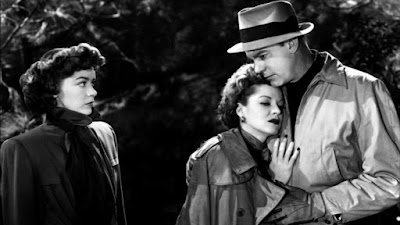So I didn't have to make a pilgrimage to Noir City to see Nightmare Alley on the big screen after all (which I thought was going to be the case when I wrote about the movie in January). A mere eleven months after my last viewing, my local art house programmed it as part of their fall film noir series. I couldn't be happier. Nightmare Alley was an "A" picture that demands to be seen big. There's usually a discussion before and after these film series showings which greatly enrich the experience and get me thinking about the movies in new ways. Here are a few of my thoughts from this showing:
- For some reason, the religiosity of the movie never registered for me before. I think this is a because religion is shown to be just another con early in the film in the aftermath of the circus being rousted by the cops. The religious element that gets taken seriously late in the film is no good for anyone, least of all our hero, Stanton Carlisle. When he starts acting like he's a preacher rather than a con artist, that's when the fall comes. Also, I never really thought of the name "Lilith Ritter" in a religious context before, but she precipitates The Fall. It's probably a stretch to call Carlisle another Adam, a la the Frankenstein monster, though.
I did not know that William Lindsay Gresham, author of the novel, had a wife who left him for C. S. Lewis. It makes me wonder a bit about whether Stanton Carlisle is meant as a kind of stand in for Lewis. Given Lewis's dubious conversion to Christianity after professing atheism early in his life, I can't help but see Carlisle as the same brand of hypocrite--at least in Gresham's mind.(edit: this speculation turns out to be groundless, per my friend Lee Price. See the comments).- Nightmare Alley is a conflation of a bunch of different film noir idioms. It's specifically at the intersection of the psychiatric noir, the epistemological noir, and the alcoholic noir. This intersection makes it a perfect film for film series where slots are limited, because it can sub for, say, The Lost Weekend or Spellbound.
- Stanton Carlisle doesn't appear to like women very much. Oh, he uses them just as he uses everyone else in the movie, but there doesn't seem to be any sexual attraction to them. Both Edmund Goulding, the director, and Tyrone Power were bisexual, and I spent part of this viewing trying to spot whether or not Nightmare Alley is coded queer. I can't decide if it is or not, apart from Carlisle's curious indifference to women. He's a bit touchy feely with men, but not in any kind of sexual way. It's a curiously asexual movie, actually, a rare film noir not motivated by lust.
- The discussion after the film touched briefly on film restoration, so I thought I'd throw out a plug for the Film Noir Foundation, which restores film noir. They were the beneficiaries of this year's Film Preservation Blogathon, and you can still donate to the cause. Here's the link:
Anyway, this remains a corker: Dark, perverse, sordid, and nasty. Just the way I like it.

































